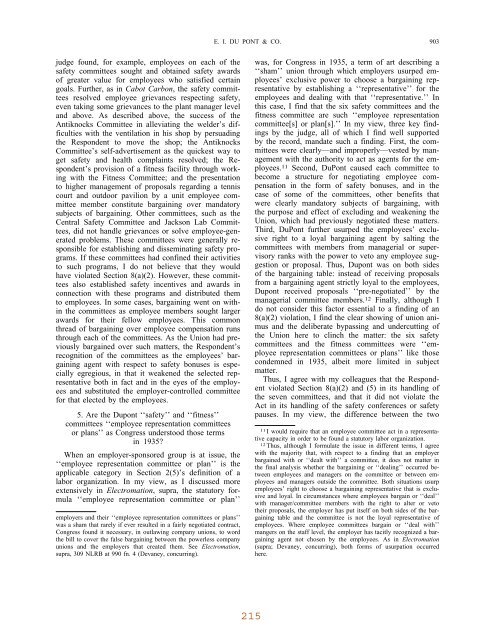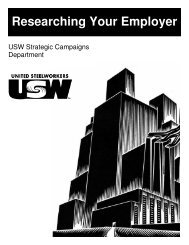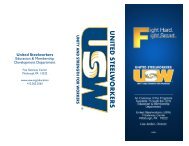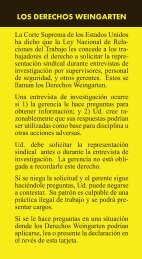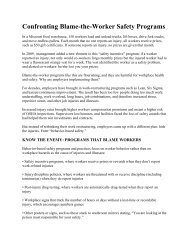Union Approach to Health and Safety: - United Steelworkers
Union Approach to Health and Safety: - United Steelworkers
Union Approach to Health and Safety: - United Steelworkers
You also want an ePaper? Increase the reach of your titles
YUMPU automatically turns print PDFs into web optimized ePapers that Google loves.
E. I. DU PONT & CO.<br />
903<br />
judge found, for example, employees on each of the<br />
safety committees sought <strong>and</strong> obtained safety awards<br />
of greater value for employees who satisfied certain<br />
goals. Further, as in Cabot Carbon, the safety committees<br />
resolved employee grievances respecting safety,<br />
even taking some grievances <strong>to</strong> the plant manager level<br />
<strong>and</strong> above. As described above, the success of the<br />
Antiknocks Committee in alleviating the welder’s difficulties<br />
with the ventilation in his shop by persuading<br />
the Respondent <strong>to</strong> move the shop; the Antiknocks<br />
Committee’s self-advertisement as the quickest way <strong>to</strong><br />
get safety <strong>and</strong> health complaints resolved; the Respondent’s<br />
provision of a fitness facility through working<br />
with the Fitness Committee; <strong>and</strong> the presentation<br />
<strong>to</strong> higher management of proposals regarding a tennis<br />
court <strong>and</strong> outdoor pavilion by a unit employee committee<br />
member constitute bargaining over m<strong>and</strong>a<strong>to</strong>ry<br />
subjects of bargaining. Other committees, such as the<br />
Central <strong>Safety</strong> Committee <strong>and</strong> Jackson Lab Committees,<br />
did not h<strong>and</strong>le grievances or solve employee-generated<br />
problems. These committees were generally responsible<br />
for establishing <strong>and</strong> disseminating safety programs.<br />
If these committees had confined their activities<br />
<strong>to</strong> such programs, I do not believe that they would<br />
have violated Section 8(a)(2). However, these committees<br />
also established safety incentives <strong>and</strong> awards in<br />
connection with these programs <strong>and</strong> distributed them<br />
<strong>to</strong> employees. In some cases, bargaining went on within<br />
the committees as employee members sought larger<br />
awards for their fellow employees. This common<br />
thread of bargaining over employee compensation runs<br />
through each of the committees. As the <strong>Union</strong> had previously<br />
bargained over such matters, the Respondent’s<br />
recognition of the committees as the employees’ bargaining<br />
agent with respect <strong>to</strong> safety bonuses is especially<br />
egregious, in that it weakened the selected representative<br />
both in fact <strong>and</strong> in the eyes of the employees<br />
<strong>and</strong> substituted the employer-controlled committee<br />
for that elected by the employees.<br />
5. Are the Dupont ‘‘safety’’ <strong>and</strong> ‘‘fitness’’<br />
committees ‘‘employee representation committees<br />
or plans’’ as Congress unders<strong>to</strong>od those terms<br />
in 1935?<br />
When an employer-sponsored group is at issue, the<br />
‘‘employee representation committee or plan’’ is the<br />
applicable category in Section 2(5)’s definition of a<br />
labor organization. In my view, as I discussed more<br />
extensively in Electromation, supra, the statu<strong>to</strong>ry formula<br />
‘‘employee representation committee or plan’’<br />
employers <strong>and</strong> their ‘‘employee representation committees or plans’’<br />
was a sham that rarely if ever resulted in a fairly negotiated contract,<br />
Congress found it necessary, in outlawing company unions, <strong>to</strong> word<br />
the bill <strong>to</strong> cover the false bargaining between the powerless company<br />
unions <strong>and</strong> the employers that created them. See Electromation,<br />
supra, 309 NLRB at 990 fn. 4 (Devaney, concurring).<br />
was, for Congress in 1935, a term of art describing a<br />
‘‘sham’’ union through which employers usurped employees’<br />
exclusive power <strong>to</strong> choose a bargaining representative<br />
by establishing a ‘‘representative’’ for the<br />
employees <strong>and</strong> dealing with that ‘‘representative.’’ In<br />
this case, I find that the six safety committees <strong>and</strong> the<br />
fitness committee are such ‘‘employee representation<br />
committee[s] or plan[s].’’ In my view, three key findings<br />
by the judge, all of which I find well supported<br />
by the record, m<strong>and</strong>ate such a finding. First, the committees<br />
were clearly—<strong>and</strong> improperly—vested by management<br />
with the authority <strong>to</strong> act as agents for the employees.<br />
11 Second, DuPont caused each committee <strong>to</strong><br />
become a structure for negotiating employee compensation<br />
in the form of safety bonuses, <strong>and</strong> in the<br />
case of some of the committees, other benefits that<br />
were clearly m<strong>and</strong>a<strong>to</strong>ry subjects of bargaining, with<br />
the purpose <strong>and</strong> effect of excluding <strong>and</strong> weakening the<br />
<strong>Union</strong>, which had previously negotiated these matters.<br />
Third, DuPont further usurped the employees’ exclusive<br />
right <strong>to</strong> a loyal bargaining agent by salting the<br />
committees with members from managerial or supervisory<br />
ranks with the power <strong>to</strong> ve<strong>to</strong> any employee suggestion<br />
or proposal. Thus, Dupont was on both sides<br />
of the bargaining table: instead of receiving proposals<br />
from a bargaining agent strictly loyal <strong>to</strong> the employees,<br />
Dupont received proposals ‘‘pre-negotiated’’ by the<br />
managerial committee members. 12 Finally, although I<br />
do not consider this fac<strong>to</strong>r essential <strong>to</strong> a finding of an<br />
8(a)(2) violation, I find the clear showing of union animus<br />
<strong>and</strong> the deliberate bypassing <strong>and</strong> undercutting of<br />
the <strong>Union</strong> here <strong>to</strong> clinch the matter: the six safety<br />
committees <strong>and</strong> the fitness committees were ‘‘employee<br />
representation committees or plans’’ like those<br />
condemned in 1935, albeit more limited in subject<br />
matter.<br />
Thus, I agree with my colleagues that the Respondent<br />
violated Section 8(a)(2) <strong>and</strong> (5) in its h<strong>and</strong>ling of<br />
the seven committees, <strong>and</strong> that it did not violate the<br />
Act in its h<strong>and</strong>ling of the safety conferences or safety<br />
pauses. In my view, the difference between the two<br />
11 I would require that an employee committee act in a representative<br />
capacity in order <strong>to</strong> be found a statu<strong>to</strong>ry labor organization.<br />
12 Thus, although I formulate the issue in different terms, I agree<br />
with the majority that, with respect <strong>to</strong> a finding that an employer<br />
bargained with or ‘‘dealt with’’ a committee, it does not matter in<br />
the final analysis whether the bargaining or ‘‘dealing’’ occurred between<br />
employees <strong>and</strong> managers on the committee or between employees<br />
<strong>and</strong> managers outside the committee. Both situations usurp<br />
employees’ right <strong>to</strong> choose a bargaining representative that is exclusive<br />
<strong>and</strong> loyal. In circumstances where employees bargain or ‘‘deal’’<br />
with manager/committee members with the right <strong>to</strong> alter or ve<strong>to</strong><br />
their proposals, the employer has put itself on both sides of the bargaining<br />
table <strong>and</strong> the committee is not the loyal representative of<br />
employees. Where employee committees bargain or ‘‘deal with’’<br />
mangers on the staff level, the employer has tacitly recognized a bargaining<br />
agent not chosen by the employees. As in Electromation<br />
(supra; Devaney, concurring), both forms of usurpation occurred<br />
here.


